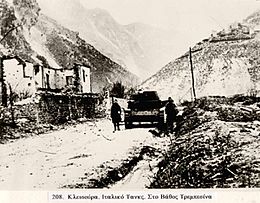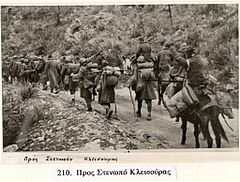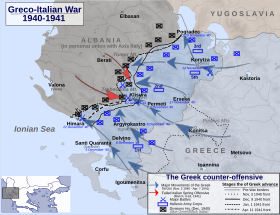Capture of Klisura Pass facts for kids
Quick facts for kids Capture of Klisura Pass |
|||||||
|---|---|---|---|---|---|---|---|
| Part of the Greco-Italian War | |||||||
 Greek soldiers next to a captured Italian tank |
|||||||
|
|||||||
| Belligerents | |||||||
| Commanders and leaders | |||||||
| Ugo Cavallero | Alexander Papagos Dimitrios Papadopoulos |
||||||
| Units involved | |||||||
| Casualties and losses | |||||||
| 300 killed & 350 captured (including 25 officers) | Unknown | ||||||
The Capture of Klisura Pass was a key battle during the Greco-Italian War. It happened in southern Albania between January 6 and 11, 1941. This battle was a major victory for Greece.
The Italian Army had attacked Greece on October 28, 1940. But after two weeks, Greece pushed the Italians back. This happened in battles like Pindus and Elaia–Kalamas. Starting in November, the Greek forces began to push deep into Italian-held Albania. Their biggest success was taking the very important Klisura Pass in January 1941.
Why Klisura Pass Was Important
After successfully pushing back the Italians, the Hellenic Army moved far into Albania. They took control of cities like Gjirokastër and Korçë by December 1940.
General Alexander Papagos, a Greek commander, wanted to move quickly. He was worried that Germany might step in to help Italy. Other generals also thought taking the Klisura Pass right away was important. This would help secure the Greek army's positions.
The Greek army had to travel long distances. Their supply lines and roads were not as good as the Italians'. The Klisura Pass was a very important spot near the town of Berat. The mountains and bad weather made fighting there extremely difficult.
The Battle for the Pass
The attack on Klisura Pass was led by the Second Army Corps. This included the 1st and 11th divisions.
During the battle, the Italians used new M13 medium tanks for the first time. These tanks belonged to the Centauro Armored Division. They attacked head-on but were destroyed by Greek artillery.
On January 10, after four days of intense fighting, the Greek infantry divisions finally captured the pass. The final push was made by the 5th Division. This division was mostly made up of soldiers from Crete.
The Italian commanders immediately tried to take the pass back. Italian Supreme Commander Ugo Cavallero ordered the Lupi di Toscana Division to help the Julia Alpine Division. But this counterattack was not well planned.
Even though they faced only four Greek battalions, the Italians quickly lost one of their own battalions. By January 11, the Italian attack had been stopped. In the next few days, the Lupi di Toscana division was almost completely destroyed. This failure meant the Greeks kept control of the pass.
What Happened Next
Taking the Klisura Pass was seen as a huge success by the Allied forces. Archibald Wavell, who commanded the British forces in the Middle East, sent a message to Alexander Papagos to congratulate him.
In the weeks that followed, the front lines became stable. The Greek forces faced problems getting supplies. The Italians managed to gather more soldiers to stop their retreat. Both sides held their positions until Germany got involved in April 1941.
On January 22, 2018, Greece and Albania made an agreement. They started working together to find the bodies of Greek soldiers who died in the battle. These soldiers will be buried in a Greek military cemetery located in the pass.




